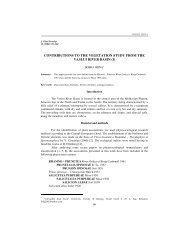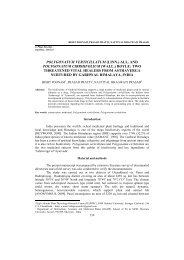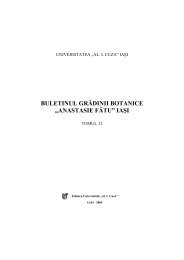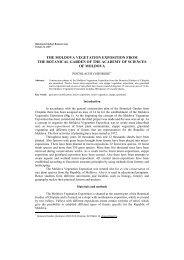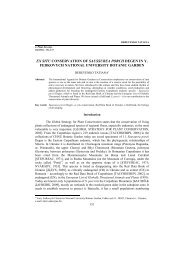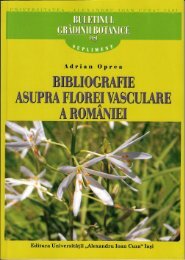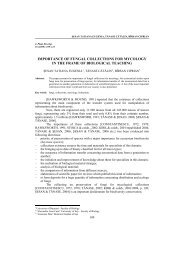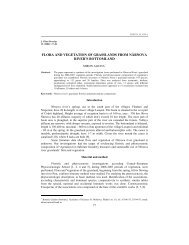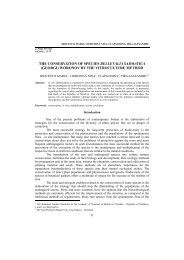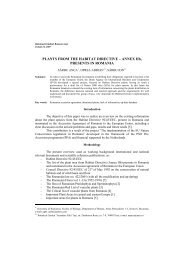taxonomic and ecologic structure of communities of edaphic algae ...
taxonomic and ecologic structure of communities of edaphic algae ...
taxonomic and ecologic structure of communities of edaphic algae ...
You also want an ePaper? Increase the reach of your titles
YUMPU automatically turns print PDFs into web optimized ePapers that Google loves.
ALARU VICTOR, TROFIM ALINA, MELNICIUC CRISTINA, DONU NATALIA<br />
J. Plant Develop.<br />
15 (2008): 3–6<br />
TAXONOMIC AND ECOLOGIC STRUCTURE OF<br />
COMMUNITIES OF EDAPHIC ALGAE FROM THE<br />
AGROPHYTOCENOSES OF THE NORTHERN<br />
DISTRICTS OF MOLDOVA<br />
ALARU VICTOR ∗ , TROFIM ALINA ∗ ,<br />
MELNICIUC CRISTINA ∗ , DONU NATALIA ∗<br />
Abstract:<br />
In this work was to establish the <strong>taxonomic</strong> <strong>and</strong> <strong>ecologic</strong> <strong>structure</strong> <strong>of</strong> algocenoses from different<br />
agricultural cultures <strong>and</strong> the conservation „in situ” through the separation in pure cultures <strong>of</strong> trunks <strong>of</strong><br />
nitrogen fixation <strong>algae</strong> that can be used in the process <strong>of</strong> soil fertility increase, as a source <strong>of</strong> nitrogen. It is<br />
worth studying the <strong>ecologic</strong> <strong>structure</strong> <strong>of</strong> <strong>algae</strong> <strong>communities</strong>, reflected by vital forms.<br />
Key words: <strong>edaphic</strong> <strong>algae</strong>, agrophytocenoses, ecobiomorphs.<br />
Introduction<br />
In the last years, <strong>edaphic</strong> <strong>algae</strong> are the object <strong>of</strong> study <strong>of</strong> a number <strong>of</strong> specialists<br />
because these organisms have an important role in stimulating soil fertility [1, 2, 3]. The<br />
study <strong>of</strong> <strong>edaphic</strong> <strong>algae</strong> is determined by their degree <strong>of</strong> participation in soil processes (the<br />
circuit <strong>of</strong> biogenic substances), in the creation <strong>of</strong> relations between different representatives<br />
<strong>of</strong> the micro-flora <strong>and</strong> superior plants. Thus, it is possible to diagnose the processes <strong>of</strong> soil<br />
creation <strong>and</strong> regulation <strong>of</strong> the agrophytocenosis productivity. On the other h<strong>and</strong>, based on the<br />
<strong>taxonomic</strong> <strong>structure</strong> <strong>and</strong> <strong>ecologic</strong> <strong>structure</strong> <strong>of</strong> the alg<strong>of</strong>lora, especially with the help <strong>of</strong> some<br />
specific species <strong>of</strong> <strong>algae</strong> from the green <strong>algae</strong> phyla, cyanophyta or xantophyta that serve as<br />
test-cultures, we can appreciate the changes that occur under the influence <strong>of</strong> different factors,<br />
including the anthropogenic ones [l].<br />
The main purpose <strong>of</strong> this work was to establish the <strong>taxonomic</strong> <strong>and</strong> <strong>ecologic</strong> <strong>structure</strong><br />
<strong>of</strong> algocenoses from different agricultural cultures <strong>and</strong> the conservation „in situ” through the<br />
separation in pure cultures <strong>of</strong> trunks <strong>of</strong> nitrogen fixation <strong>algae</strong> that can be used in the process<br />
<strong>of</strong> soil fertility increase, as a source <strong>of</strong> nitrogen.<br />
Materials <strong>and</strong> methods<br />
The <strong>edaphic</strong> <strong>algae</strong> <strong>communities</strong> have been analyzed from samples collected in 2007<br />
from the chernozem occupied by different agricultural cultures: wheat, barley, sunflower,<br />
oats, sugar beet, corn etc. from the northern districts <strong>of</strong> Moldova. The collection <strong>and</strong><br />
processing <strong>of</strong> soil samples have been carried out using the methods accepted in modern<br />
algology [2].<br />
∗ Department <strong>of</strong> Ecology, Botany <strong>and</strong> Silviculture, Algaeology Laboratory, State University <strong>of</strong> Moldova<br />
3
TAXONOMIC AND ECOLOGIC STRUCTURE OF COMMUNITIES OF EDAPHIC ALGAE ….<br />
Results <strong>and</strong> discussions<br />
The investigations made on <strong>algae</strong> <strong>communities</strong> have shown a varied alg<strong>of</strong>lora, both by<br />
the <strong>taxonomic</strong> <strong>structure</strong> <strong>and</strong> by the biologic particularities <strong>of</strong> species, which includes a total <strong>of</strong><br />
63 species <strong>and</strong> genera <strong>of</strong> <strong>algae</strong> from 10 families <strong>and</strong> 22 genera. The largest number <strong>of</strong> <strong>algae</strong> has<br />
been detected on agricultural l<strong>and</strong>s occupied by barley, sunflower <strong>and</strong> corn cultures, <strong>and</strong> the<br />
minimum value has been identified in wheat <strong>and</strong> sugar beet cultures. If we speak about the<br />
<strong>structure</strong> <strong>of</strong> phyla, the development <strong>of</strong> green-blue <strong>algae</strong> is predominant in all the cultures.<br />
The second place by the variety <strong>of</strong> species is held by bacillariophyta that vegetate<br />
actively in the soil occupied by barley <strong>and</strong> potato cultures. The relatively high diversity is<br />
probably due to the use <strong>of</strong> water from reservoirs for irrigation. Thus, these two groups<br />
make up from the number <strong>of</strong> <strong>algae</strong>.<br />
The most sensible are the xantophyta <strong>algae</strong> that are present only in the fields <strong>of</strong> wheat <strong>and</strong> soya,<br />
which shows the lack <strong>of</strong> pollution with chemical substances (pesticides, herbicides, etc.).<br />
The Euglenophyta have disappeared from the list <strong>of</strong> species, which proves that they are not<br />
typical <strong>of</strong> algocenoses from the soil (tab. 1).<br />
Table 1<br />
Taxonomic <strong>structure</strong> <strong>of</strong> <strong>algae</strong> <strong>communities</strong> that vegetate the agrocenoses in the north <strong>of</strong> Moldova.<br />
Fields with<br />
cultures<br />
Groups<br />
<strong>of</strong> <strong>algae</strong><br />
Potato Soya Sunflower Corn Barley Wheat Sugar beet Lucern<br />
Cyanophyta 11 12 15 13 20 7 7 12<br />
Chlorophyta 1 - 1 1 2 1 3 1<br />
Xantophyta - 1 - - - 2 - -<br />
Bacilariophyta 2 2 1 2 5 2 - 2<br />
Euglenophyta - - - - - - - -<br />
Total no. <strong>of</strong> sp. 14 15 17 16 27 12 10 15<br />
Data from the previous table on the distribution <strong>of</strong> species by phyla show that the<br />
established laws are generally maintained:<br />
Cyanophyta (46) – Bacilariophyta(6) – Xantophyta (3) – Chlorophyta (8) —<br />
Euglenophyta (missing). The field with sunflower culture is predominantly occupied by cyanophyta,<br />
soya has two species <strong>of</strong> diatom from the Navicula variety, as compared to algocenosis from the<br />
wheat culture that includes all the representatives <strong>of</strong> phyla (tab. 1), a pro<strong>of</strong> <strong>of</strong> the optimal conditions<br />
for the development <strong>of</strong> <strong>edaphic</strong> <strong>algae</strong>.<br />
By comparing the <strong>structure</strong> <strong>of</strong> predominant species in cultivated crops <strong>and</strong> noncultivated<br />
crops, we can see that there are differences. For instance, agrocenoses with cultivated<br />
crops are dominated by Phormidium species (Ph. molie, Ph. jadinianum, Ph. foveolarum) <strong>and</strong><br />
Nostoc, the non-cultivated crops are dominated by Phormidium species <strong>and</strong> by Lyngbia species (L.<br />
cryptovaginata, L. attenuata, L. martensiana), the intensive development creates a gelatinous film<br />
on the soil surface. Thus, the action <strong>of</strong> mechanic soil processing creates unstable <strong>and</strong> diverse<br />
4
ALARU VICTOR, TROFIM ALINA, MELNICIUC CRISTINA, DONU NATALIA<br />
conditions, creating preconditions for the development <strong>of</strong> <strong>algae</strong> species <strong>of</strong> different groups:<br />
Phormydium, Oscilatoria, Nostoc, Cylindrospemum, Navicula, Hantzchia, Symploca etc.<br />
It is also worth mentioning that species <strong>of</strong> nitrogen fixation <strong>algae</strong> that exercise an<br />
obvious action on the balance <strong>of</strong> nitrogen from the soil that is required for the growth <strong>of</strong><br />
superior plants. The presence <strong>of</strong> a sufficient number <strong>of</strong> species is a pro<strong>of</strong> <strong>of</strong> natural soil fertility.<br />
Some trunks <strong>of</strong> species have been selected in pure cultures: from the soya field - Nostoc sp.,<br />
Cylindrospermum sp. <strong>and</strong> from the sunflower field - Nostoc punctiforme (Quitz), that develop<br />
intensely on different nutritive media <strong>and</strong> fix to a large extent the free nitrogen in atmosphere to be<br />
then proposed as sources <strong>of</strong> enrichment <strong>of</strong> the soil with nitrogen with a view to increase its fertility.<br />
It is worth studying the <strong>ecologic</strong> <strong>structure</strong> <strong>of</strong> <strong>algae</strong> <strong>communities</strong>, reflected by<br />
vital forms. The distribution <strong>of</strong> <strong>algae</strong> by ecobiomorphs is represented in figure 1.<br />
Fig. l. Distribution <strong>of</strong> <strong>algae</strong> from the agrocenoses <strong>of</strong> the northern region <strong>of</strong> Moldova by<br />
ecobiomorphs.<br />
A specific particularity <strong>of</strong> agrophytocenoses is the full predominance <strong>of</strong> P forms<br />
making up 80% <strong>and</strong> are represented by Oscillatoria, Phormidium, Symploca i Lyngbya<br />
genera that are found in all the agricultural cultures.<br />
An important role <strong>of</strong> the <strong>ecologic</strong> state <strong>of</strong> soils is usually held by xantophyta <strong>algae</strong><br />
that represent species <strong>of</strong> <strong>algae</strong> resistant to shadow, but sensible to draught <strong>and</strong> extreme<br />
temperatures. The most typical for the studied agrocenoses are the species Chlorellidium<br />
tetrabotrix, Chlorocloster terrestris. The nitrogen fixation species from Nostoc, Anabena,<br />
Cylindrospermum genera are close to this group <strong>and</strong> are joined in ecobiomorph. Cf.<br />
Overall, these forms are represented by 7 species that make up about 11% <strong>of</strong> the total<br />
number <strong>of</strong> species, a pro<strong>of</strong> <strong>of</strong> natural soil fertility.<br />
Conclusion<br />
The complex analysis <strong>of</strong> <strong>edaphic</strong> alg<strong>of</strong>lora from agrocenoses has demonstrated<br />
that specific environment conditions are created in these soils, in relation to the use <strong>of</strong><br />
irrational agricultural technologies. These conditions are reflected in the change <strong>of</strong> the<br />
<strong>structure</strong> <strong>of</strong> <strong>algae</strong> group species <strong>and</strong> in the modification <strong>of</strong> the relation between the main<br />
phyla <strong>of</strong> <strong>algae</strong>. These are the reasons for the number <strong>of</strong> green <strong>and</strong> blue <strong>algae</strong> <strong>and</strong> the<br />
considerable reduction <strong>of</strong> the diversity <strong>of</strong> xantophyta <strong>algae</strong> in most <strong>of</strong> the cultures.<br />
5
TAXONOMIC AND ECOLOGIC STRUCTURE OF COMMUNITIES OF EDAPHIC ALGAE ….<br />
References<br />
1. ALARU V., 2001 – Algele edafice din fitocenozele Republicii Moldova. Analele tiinifice ale Universitii<br />
de Stat din Moldova. Chiinu: 162-168.<br />
2. ALARU V., CHICU N., DUDNICENCO T., 2004 – Algele i rolul lor în sporirea fertilitii solului.<br />
Culegeri de lucrri tiinifice, Chiinu, Tip. " Sirius": 113-121.<br />
3. ALARU V., 2001 – Rolul algelor edafice în sporirea fertilitii solului. Lucrrile conferinei tiinifice cu<br />
participare internaional “Solul i viitorul”, Chiinu:.292 p.<br />
4. ., ., 1969 – . .: !" , 228.<br />
6



